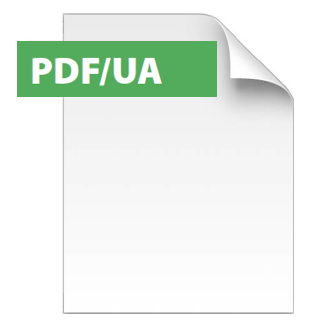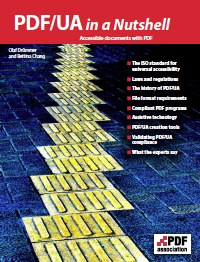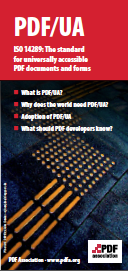

Part of NewFormat AB Portal
 
OpenFormat
Products and Services
Offerings / Promotions / Prices
Guides and Datasheets
Customer Contact Form
Home/NewFormat
NewFormat AB
PDF standards make the world work
NewFormat makes PDF information permanently
accessible, searchable, readable and reusable
for the future and for as many people as possible.
We leave no file behind.
We create accessible PDF in compliance with the ISO Standard PDF/UA.
Our solutions are based on
recognized ISO Standards based on PDF technology
and tested, reliable, and highly accessible software solutions from
the PDF Association vendor community.
|

Accessible PDF
A fully PDF/UA compliant PDF can be just as
accessible as a WCAG compliant website.
|

Recommended Software Tools and Services to
Tag, Create, Check/Validate and Remediate/Correct PDF files for
Compliance with the ISO Standard 14289, PDF/UA,
for Universally Accessible PDF
Software tools and services below are offered for a fee
except for all those marked as
completely free (no-cost) to use
Best approach to create Accessible PDF, direct or indirect?
In principle, universally accessible PDF documents can either be
generated directly during document creation, using a suitable program,
or indirectly generated by adapting an existing PDF document.
The indirect approach tends to require a great deal of work,
as all tags and numerous other settings will need to be provided manually.
This work can also become void as soon as a new version of the PDF document
replaces the old one, if any changes to the document’s content need to be made.
The adaptation process must then be started again from scratch.
The direct approach is almost always the better option;
post-creation PDF edits should be avoided or at least kept to a minimum.
Either way, it is essential that the document creation program can perform
the functions required and that the document creator can make use of them.
The best way to ensure accessibility for PDF files
is by combining several different testing methods::
- A series of automated tools designed to evaluate
specifically for digital accessibility, and
- Manual checks, and
- Human user checks
Time is money! - Invest in "PDF/UA-Ready" software tools
The process to build accessible documents is far from always straightforward.
To quickly make something barrier-free by pressing a few buttons
in your ordinary software tool do not usually lead to a successful result.
Strive to minimize the time using software tools that
can not natively export PDF/UA compliant documents.
The part you do in Adobe InDesign or MS Office is like
pouring the foundation of a house:
It’s a critical first step, but there’s a lot more work ahead
(in the form of what is called "PDF remediation")
before the job is done.
For this reason,
third-party tools and services are available to ease the process.
So, instead of spending endless hours with substandard software tools,
invest a small amount in complementary aids and software tools
that are "PDF/U-Ready".
By using "PDF/UA-Ready" software tools, you significantly shorten
the working time to create accessible PDF.
Passing with a software tool / PDF Accessibility Checker
is only the first step to remediating a document.
Please be aware, it can happen that your PDF accessibility checker software
will miss to fail even simple errors and obvious accessibility barriers;
errors that can cause the PDF to fail accessibility requirements,
but pass your accessibility checker.
To avoid this, we recommend that you invest some time to correctly
tag the most basic document structures in your PDF file:
- Text Paragraphs
- Layout Tables
- Use of Color / Sufficient Contrast
- Content Order / Reading Order
- Insufficient Alt-text
- Decorative Items
- Irregular Tables,
and that Headings apply to intended Table Columns/Rows
|
Recommended actions
for anyone that has
need, interest, drive and time to
independently explore and learn
how to make PDF files digitally accessible
Read this book:
"Create Accessible PDF Documents,
The Practical Hands-On Manual For Everyday Work"
Recommended (indispensable) reading for those who want to
know more about how to practically create digitally accessible PDF.

The main aim of this book is to enable all readers to
create barrier-free/digitally accessible documents
independently and as effectively as possible with
the most commonly used office software.
This includes knowing what an accessible PDF is
and how to prepare your content accordingly,
planning production processes and
detailed practical implementation
in those popular software programs.
Includes a lot of examples and valuable checklists
for implementation in Adobe InDesign,
Microsoft Office, and LibreOffice.
Note! This book is only available in German.
Available to order online today from dpunkt.verlag.de:
Join the global
"PDF Accessibility Community"

Users and PDF accessibility experts from all over the globe
join forces in the global "The PDF Accessibility Community".
Together they explore and share experiences of
the world of digitally accessible documents;
what is digitally accessible PDF and how to do,
hands-on tips and recommendations,
related PDF tags and correct tagging of
PDF documents for digital accessibility,
WCAG success criteria and real-world issues
related to PDF accessibility, etc.:
Resources:
Interesting?
|

Why not solely use the well-known software tools
Microsoft Office, Adobe InDesign, Adobe Acrobat,...
to create, check/validate or read Accessible PDF?
It is not the assistive technologies, nor popular software tools
such as MS Office with Microsoft Office Accessibility Checker,
Adobe InDesign, Adobe Reader, Adobe Acrobat Standard,
Adobe Acrobat Pro with Adobe Acrobat Pro Accessibility Checker,
Google Docs, Apple iWork,...
that define what is an accessible PDF.
A PDF document is defined as "accessible PDF" only when it
meets the ISO Standard PDF/UA-1 with guidelines,
and applicable parts of the WCAG 2.1 AA recommendations!
Although there are a number of PDF/UA validation software options,
not all offer a complete set of both automated and manual checks,
as is required for full verification of conformance to PDF/UA.
Also, be aware of the this very important disclaimer
by Adobe Systems concerning:
- Adobe Acrobat Reader och Adobe Acrobat Standard:
"Adobe Acrobat Reader and Adobe Acrobat Standard
do not have the complete set of tools needed to
create and validate PDF documents for accessibility".
See the full Adobe Disclaimer at Adobe's web page:
Currently, the above mentioned software tools,
which are used by many users to create and edit
PDF documents, are usually not sufficiently "PDF/UA-Ready";
they lack the ability to always correctly export a final
PDF document according to PDF/UA and they do not
check/validate well enough to comply with the PDF/UA standard.
The exported PDF file thus risks not being "accessible PDF"
nor meet the accessibility requirements under
the EU Web Accessibility Directive or the Swedish Act on
Accessibility to Digital Public Services for everyone!
Just because you tag a PDF document with
Adobe Acrobat Pro or MS Office and the file
then pass the accessibility check with
- Adobe Acrobat Pro Accessibility Checker, or with
- Microsoft Office Accessibility Checker
the PDF file can still have severe accessibility errors,
especially if the file contains data tables or other complex structures.
So don't expect too much from these control features for now.
Note! Regarding Adobe Acrobat Accessibility Checker!
For Adobe Acrobat Pro, Adobe Systems recommend to use
"Adobe Acrobat Pro Accessibility Checker" for compliance checking
against current standards for digital accessibility,
but unfortunately it is completely misleading.
It gives the impression that Adobe Acrobat Pro Accessibility Checker
performs a very comprehensive and thorough checking for compliance
with all globally recognized digital accessibility standards,
but it turns out that Adobe Acrobat Pro Accessibility Checker
unfortunately does not perform that check at all!
Adobe Acrobat Pro Accessibility Checker does not check to any known standard;
for instance, it does not check all of the checkpoints for WCAG compliance,
and the accessibility report that Adobe Acrobat Pro Accessibility Checker
provides has nothing to do with a real preflight!
Adobe Acrobat Pro Accessibility Checker only checks for
common issues you are likely to encounter,
but it is not a full check.
There can still be problems with the file that
the Adobe Acrobat Pro Accessibility Checker is not identifying.
This is also confirmed by
the Adobe Acrobat Pro Accessibility Checker Disclaimer:
"Note: While the Accessibility Checker helps evaluate
the accessibility of a document and helps identify areas
that may be in conflict with Adobe’s interpretations of
the referenced guidelines, the Accessibility Checker can not
automatically check all accessibility guidelines and criteria,
including those in such referenced guidelines,
and Adobe does not warrant that any documents
will comply with any specific guidelines or regulations."
See the full Adobe Disclaimer at Adobe's web page:
This also explains why most PDF files that pass
Adobe Acrobat Pro Accessibility Checker without remarks
does not meet the technical requirements for accessible PDF:
Instead, this is the preferred method to check for syntax compliance
with the ISO standard PDF/UA in Adobe Acrobat Pro:
- Select feature: "Tools"
- Select feature: "Print production"
- Select feature: "Preflight"
- Select in the top tab: "PDF standards"
- Select in tab "Profiles: PDF/UA compliance,
Verify compliance with PDF/UA-1"
(Worth knowing:
The Preflight features for the PDF/UA check in Adobe Acrobat
is developed by callas software and included under
OEM contract in Adobe's software products.
However, not all functionality for controls, adjustments,
actions and fixes that callas software develops for Preflight
are always included by Adobe in Adobe Acrobat Preflight.
In general, the preflight features from callas software have
a more frequent update interval than Adobe Acrobat Preflight.
This means that new functions are available earlier in callas products.
For access to the very latest updated and most complete
preflight technology as well as all functions to fix any
syntax problems discovered during preflight,
it is highly recommended that you instead use
callas pdfToolbox, callas pdfaPilot and callas pdfGoHTML)
Tricky use case:
Accessible complex data tables with
Adobe InDesign plus Adobe Acrobat Pro DC
All tables, even complex data tables
(tables with multi-column headers and multi-row headers)
can be designed to be accessible tables in PDF documents.
A typical use case where native Adobe InDesign fails
is tagging of complex data tables.
As of today, Adobe InDesign can not natively export PDF/UA compliant files.
Adobe's recommendation is to first export the PDF file out of InDesign,
and then in a follow-on step undertake required post-processing fixes in
the PDF file with Adobe Acrobat Pro DC to make the file PDF/UA compliant.
In theory complex data tables could be tagged in Adobe Acrobat Pro DC,
but it is in practise a cumbersome and very time-consuming process and
requires and consumes an unreasonable number of working hours of your time.
However, alternative, and "PDF/UA-Ready", software tools are
available that offer in-built and out of the box support for tagging of
complex data tables in minutes, or at least with less effort,
and thereafter export of PDF/UA compliant documents,
in a significantly shorter time.
Interesting?
|
"PDF/UA-Ready" software tools
Regardless of what software tool you prefer to use to create accessible PDF,
make sure you really understand how the tool works, because then it is
more flexible and you will get the most out of it.
Users often claim:
"PDF documents are not just accessible as source documents created with
software tools such as MS Word, MS PowerPoint, Adobe InDesign, and others."
That is just not true!
The PDF specification provides robust support for accessibility.
The accessibility of any individual PDF file depends on
how well the author prepared the file for accessibility.
The problem is that most users who are creating PDFs
don't know how to properly use said source software tools
(MS Word, MS PowerPoint, Adobe InDesign, etc.)
and they aren't incorporating accessibility features
into the source file either.
Or they may even export to PDF in a way that
negatively affects the accessibility of the PDF.
The truth is:
It is all in how the source file was set up and
how the PDF document was exported.
Make sure you prepare your source document correctly
because then the exported PDF is going to be pretty accessible.
Questions to ask yourself:
- Do I really understand how the software tool works?
- Did I create my document the way the software tool was intended?
- Did I use the tool the right way?
- Did I use Styles?
- Did I use Tables to layout my three column layout
rather than actual columns?
- Did I use Lists?
- ...and other related questions
"PDF/UA-Ready" software tools has the ability to verify/confirm PDF/UA
conformance based on the Matterhorn Protocol's set of checks.
It is also required that you understand and can apply
requirements for checkpoints and tags according to
the PDF/UA standard
To get the benefit of PDF/UA-1 users will need software
that supports PDF 1.7 and PDF/UA-1.
To get the benefit of Well-Tagged PDF (WTPDF) or PDF/UA-2
users will need software that supports PDF 2.0 and PDF/UA-2.
However, to correctly create accessible PDF more is required
than just "PDF/UA-Ready" software tools.
It is also required that you understand and can apply
requirements for checkpoints and tags according to
the PDF/UA standard.
The reality is that PDF remediation isn’t quick, easy, or straightforward.
It also requires skill, knowledge, and experience on your part
in remediating the PDF file.
The more knowledge you have,
the more you know about the process,
the easier the process becomes.
Does the necessary work effort feel overwhelming?
Anything you can use to streamline the process
can significantly change your workflow for the better.
An individual user can probably manually create and manage
a certain limited number of PDF documents, depending on
the number of pages and complexity.
In case of need to create and maintain many hundreds or even
thousands of documents, we highly recommend the use of
solutions that do support large-scale production and
automated workflow processes.
Does the necessary work effort feel overwhelming?
Then we recommend:
Interesting?
|
Wide range of "PDF/UA-Ready" software tools to use, and free trials
For full information on software tools, provided by NewFormat,
that do support accessible PDF (PDF/UA), download of free trials,
tutorials, recorded demonstrations, etc.,
click on the preferred tools/links below.
Interesting?
|
Tools for adding/creating tags in source files and PDF documents
Software tools with the ability to add/create tagged PDF documents
with semantically appropriate structure elements from
a source file or existing untagged PDF.
Note!
Applying tags to a PDF is a needed fix
in making a digitally accessible PDF file;
correct tags in correct order is a prerequisite
to create a fully PDF/UA compliant PDF file.
Tagging of PDF documents for compliance with PDF/UA-1.
Recommended guides on to how to correctly tag
PDF documents according to PDF/UA-1:
"PDF/UA-Ready" software tools for TAGGING of PDF documents / Tagged PDF:
axaio MadeToTag for Adobe InDesign Plugin to Adobe InDesign. For Windows and macOS.
Creates tags according to the PDF/UA-1 Standard.
Significantly speeds up the tagging work in Adobe InDesign!
axesWord for MS Word Plugin to MS Word for Windows.
Creates tags according to the PDF/UA Standard.
Facilitates the tagging process based on templates.
axesSlide for MS PowerPoint Plugin to MS PowerPoint for Windows.
Creates tags according to the PDF/UA Standard.
Facilitates the tagging process based on templates.
CommonLook Office for MS Word and MS PowerPoint Plugin to MS Office for Windows.
Creates tags according to the PDF/UA Standard.
Facilitates the tagging process.
Foxit PDF Editor Suite Pro For Windows, Apple macOS, Apple iOS, Android and browsers.
Create, edit and manage PDF Documents, and sign anywhere.
PDFs can be optimized for accessibility.
(The version for Windows supports most features).
PDFix Desktop Pro For Windows, Apple macOS, Linux.
Create, edit, check/validate and manage PDF files,
PDFs can be optimized for accessibility.
PDFix SDK For Windows, Linux.
For enterprise workflows.
Automatically extract logical content and
add structure to any PDF file.
Create, edit, check/validate and manage PDF files,
PDFs can be optimized for accessibility.
PDFix.io Online Tools Free (No-Cost) Online PDF Tools,
to manually and easily process digital PDF files online.
Interesting?
|
Tools for creating accessible PDF according to the PDF/UA standard
"PDF/UA-Ready" software tools with the ability to create PDF documents
conforming to PDF/UA (ISO 14289-1:2014).
"PDF/UA-Ready" software tools for CREATING accessible PDF according to ISO PDF/UA:
AbleDocs Grackle Suite Document Accessibility Checker/Plugin for Google Workspace;
Google Docs, Google Slides, Google Sheets.
axaio MadeToTag for Adobe InDesign Plugin to Adobe InDesign. For Windows and macOS.
No need for revision / post-processing in Adobe Acrobat!
Creates PDF files compliant with ISO PDF/UA-1 and PDF/A-2a.
axesPDF Extended/professional version of PAC for Windows.
Corrects any existing PDF for compliance with ISO PDF/UA-1.
axesWord for MS Word Plugin to MS Word for Windows.
Creates PDF files compliant with ISO PDF/UA-1 and PDF/A-2a.
axesSlide for MS PowerPoint Plugin to MS PowerPoint for Windows.
Creates PDF files compliant with ISO PDF/UA-1 and PDF/A-2a.
CommonLook Office for MS Word and MS PowerPoint Plugin to MS Office for Windows.
Creates PDF files compliant with
ISO PDF/UA-1, WCAG 2.0, U.S. Section 508 and/or U.S. HHS.
CommonLook PDF Plugin to Adobe Acrobat for Windows.
Creates PDF files compliant with
ISO PDF/UA-1, WCAG 2.0/2.1, U.S. Section 508 and/or U.S. HHS.
Foxit PDF Editor Suite Pro For Windows, Apple macOS, Apple iOS, Android and browsers.
Create, edit and manage PDF Documents, and sign anywhere.
PDFs can be optimized for accessibility.
(The version for Windows supports most features).
PDFix Desktop Pro For Windows, Apple macOS, Linux.
Create, edit, check/validate and manage PDF files,
PDFs can be optimized for accessibility
in compliance with PDF/UA-1.
PDFix SDK For Windows, Linux.
For enterprise workflows.
Automatically extract logical content and
add structure to any PDF file.
Create, edit, check/validate and manage PDF files,
PDFs can be optimized for accessibility
in compliance with PDF/UA-1.
PDFix.io Online Tools Free (No-Cost) Online PDF Tools,
to manually and easily process digital PDF files online.
Interesting?
|
Tools for remediation/correction of inaccessible PDF
to accessible PDF according to the PDF/UA standard
"PDF/UA-Ready" software tools with the ability to remediate/correct
the logical structure tree of a tagged PDF file.
"PDF/UA-Ready" software tools for REMEDIATING/CORRECTING inaccessible PDF
to be in compliance with ISO PDF/UA, thus being accessible PDF:
axesPDF Extended/professional version of PAC for Windows.
Corrects any existing PDF for compliance with ISO PDF/UA-1.
callas pdfaPilot Desktop Runs standalone,
or as plugin to Adobe Acrobat Standard or Pro.
For Windows , Apple macOS and Linux.
callas pdfaPilot can resolve, via "Preflight",
some common problems related to PDF/UA files;
"Resolve structural problems with tagged PDF documents".
callas pdfToolbox Desktop Runs standalone,
or as plugin to Adobe Acrobat Standard or Pro.
For Windows , Apple macOS and Linux.
callas pdfToolbox can resolve, via "Preflight",
some common problems related to PDF/UA files;
"Resolve structural problems with tagged PDF documents".
CommonLook PDF Extended/professional version of CommonLook PDF Validator.
Plugin to Adobe Acrobat for Windows.
Corrects for compliance with
ISO PDF/UA-1, WCAG 2.0/2.1, U.S. Section 508 and/or U.S. HHS.
Foxit PDF Editor Suite Pro For Windows, Apple macOS, Apple iOS, Android and browsers.
Create, edit and manage PDF Documents, and sign anywhere.
PDFs can be optimized for accessibility.
(The version for Windows supports most features).
PDFix Desktop Pro For Windows, Apple macOS, Linux.
Create, edit, check/validate and manage PDF files,
PDFs can be optimized for accessibility
in compliance with PDF/UA-1.
PDFix SDK For Windows, Linux.
For enterprise workflows.
Automatically extract logical content and
add structure to any PDF file.
Create, edit, check/validate and manage PDF files,
PDFs can be optimized for accessibility
in compliance with PDF/UA-1.
PDFix.io Online Tools Free (No-Cost) Online PDF Tools,
to manually and easily process digital PDF files online.
Interesting?
|
Tools for validation of PDF files for
compliance with the PDF/UA standard
"PDF/UA-Ready" software tools with the ability to verify/confirm PDF/UA
conformance based on the Matterhorn Protocol's set of checks.
A PDF document’s degree of accessibility is hard to determine at first glance.
How, then, can you tell if and to what extent a PDF file meets
the requirements of PDF/UA?
A reliable compliance test always depends
on at least two stages of validation:
- a programmatic syntactic test,
which can be performed by a trusted software, and
- an interactive semantic test,
manually carried out by a human.
Dedicated validation/accessibility checker/test tools help the user
to perform the programmatic syntactic test.
They test and show the extent to which the PDF document meets
the standard’s purely technical requirements (including requirements
for tag-based document structuring of document title, headings,
paragraphs, columns, tables, alternative text for images, etc...)
and uses the correct syntax to implement them.
For programmatic PDF/UA and WCAG compliance validation of a PDF document,
we recommend to check/validate the document with more than one test tool.
Note! Passing the programmatic syntactic test with an accessibility checker
is only the beginning of ensuring a document is accessible.
The semantic aspects of PDF/UA, however,
cannot be tested in the same way:
- Is the reading order logical?
- Does the alternative text adequately represent the same
information as the images to which it is attached?
- Do the header tags reflect their corresponding header levels?
These and other questions can only be answered after
evaluation and testing by a human user,
as only a human review can ensure a good user experience.
Both PDF/UA and WCAG always requires human interaction;
an interactive semantic test, manually carried out by a human.
One further test (which should be run on at least a random
sample of all documents created) is to use the PDF document
with a selection of current types of assistive technology.
Regular users of the technology can be enlisted to test
the documents in this way; in most cases, however,
anyone can in principle perform a useful test with assistive
technology to confirm the readability of the PDF document.
One very simple option here is to use the free (no-cost),
and "PDF/UA-Ready", screen reader application:
A user can quickly get to grips with the core functions of
the NVDA software in order to test how well people with disabilities
can actually use an existing (ideally fully PDF/UA compliant) document.
"PDF/UA-Ready" software tools for CHECKING/VALIDATING
accessible PDF according to ISO PDF/UA:
ADScan Online Services.
Organization-wide Internal and External Website
Document Accessibility Checker.
ADScan for Wordpress Online Services.
WordPress Website
Document Accessibility Checker.
PDF Accessibility Checker (PAC) Free/No-cost. For Windows.
Quick check of a PDF file for compliance with ISO PDF/UA-1
and applicable parts of WCAG 2.1 AA recommendations.
Also performs automatic color contrast control.
axesCheck Free/No-cost web-based service.
Web-based version of PDF Accessibility Checker (PAC).
Quick check of a PDF file for compliance with ISO PDF/UA-1
and applicable parts of WCAG 2.1 AA recommendations.
axesSense For integration of automatic check for PDF accessibility, according to
PDF/UA-1 and applicable parts of W3C/WCAG 2.1 AA recommendations,
into systems or software as a REST API.
axesPDF Extended/professional version of PAC for Windows.
Checks/Validates any existing PDF for compliance with ISO PDF/UA-1.
callas pdfaPilot Desktop Runs standalone,
or as plugin to Adobe Acrobat Standard or Pro.
For Windows , Apple macOS and Linux.
callas pdfaPilot can resolve, via "Preflight",
some common problems related to PDF/UA files;
"Resolve structural problems with tagged PDF documents".
The feature for validation of PDF/UA compliance
can be used without cost.
callas pdfToolbox Desktop Runs standalone,
or as plugin to Adobe Acrobat Standard or Pro.
For Windows , Apple macOS and Linux.
callas pdfToolbox can resolve, via "Preflight",
some common problems related to PDF/UA files;
"Resolve structural problems with tagged PDF documents".
The feature for validation of PDF/UA compliance
can be used without cost.
CommonLook PDF Validator Free/No-cost plugin to Adobe Acrobat for Windows.
First fast way to check/validate a PDF file for compliance with
ISO PDF/UA-1, WCAG 2.0/2.1, U.S. Section 508 and/or U.S. HHS.
CommonLook PDF Extended/professional version of CommonLook PDF Validator.
Plugin to Adobe Acrobat for Windows.
Checks/Validates for compliance with
ISO PDF/UA-1, WCAG 2.0/2.1, U.S. Section 508 and/or U.S. HHS.
Foxit PDF Editor Suite Pro For Windows, Apple macOS, Apple iOS, Android and browsers.
Create, edit and manage PDF Documents, and sign anywhere.
PDFs can be optimized for accessibility.
(The version for Windows supports most features).
PDFix Desktop Lite For Windows, Apple macOS, Linux.
Free (no-cost) multiplatform
PDF Reader / Viewer and
PDF Validator / PDF Accessibility Checker.
PDFix Desktop Pro For Windows, Apple macOS, Linux.
Create, edit and manage PDF files,
PDFs can be optimized for accessibility.
PDFix SDK For Windows, Linux.
For enterprise workflows.
Automatically extract logical content and
add structure to any PDF file.
Create, edit and manage PDF files,
PDFs can be optimized for accessibility.
PDFix.io Online Tools Free (No-Cost) Online PDF Tools,
to manually and easily process digital PDF files online.
veraPDF GUI For Windows, Apple macOS and Linux running Java 8 or later.
Open source project.
GUI (Graphical User Interface) for manual interaction.
Checks/Validates for compliance with ISO PDF/UA (programatic syntax check).
Interesting?
|
Tools for quick viewing/checking/reading of
the tagging structure in PDF files
"PDF/UA-Ready" software tools with the ability of product that includes
an end-user-oriented interactive PDF (or PDF-alternative) viewer that
uses tagged PDF to make PDF/UA files available to Assistive Technology.
"PDF/UA-Ready" software tools for VIEWING, CHECKING and READING
the tagging structure in PDF files, and assistive technologies
such as PDF reading tools and screen reading tools:
AbleDocs ADReader Free/No-cost.
For Apple iOS and Android.
Viewer/Reader app for
PDF/UA compatible files on mobile devices.
PDF Accessibility Checker (PAC) Free/No-cost.
For Windows.
Review quickly the tagging structure of a PDF file
for compliance with PDF/UA-1.
Also performs automatic color contrast control.
axesPDF Extended/professional version of PAC for Windows.
Checks/Validates any existing PDF for compliance with ISO PDF/UA-1.
callas pdfGoHTML Free/No-cost.
Plugin for Adobe Acrobat DC on Windows and Apple macOS.
First fast way to view the tagging structure of a PDF file.
callas pdfaPilot Desktop Runs standalone,
or as plugin to Adobe Acrobat Standard or Pro.
For Windows , Apple macOS and Linux.
callas pdfaPilot can resolve, via "Preflight",
some common problems related to PDF/UA files;
"Resolve structural problems with tagged PDF documents".
The VIEWER feature to view the tagging structure of a PDF file
can be used without cost.
callas pdfToolbox Desktop Runs standalone,
or as plugin to Adobe Acrobat Standard or Pro.
For Windows , Apple macOS and Linux.
callas pdfToolbox can resolve, via "Preflight",
some common problems related to PDF/UA files;
"Resolve structural problems with tagged PDF documents".
The VIEWER feature to view the tagging structure of a PDF file
can be used without cost.
Foxit PDF Editor Suite Pro For Windows, Apple macOS, Apple iOS, Android and browsers.
Create, edit and manage PDF Documents, and sign anywhere.
PDFs can be optimized for accessibility.
(The version for Windows supports most features).
PDFix Desktop Lite For Windows, Apple macOS, Linux.
Free (no-cost) multiplatform
PDF Reader/Viewer and
PDF Validator/Accessibility Checker.
PDFix Desktop Pro For Windows, Apple macOS, Linux.
Create, edit and manage PDF files,
PDFs can be optimized for accessibility.
PDFix SDK For Windows, Linux.
For enterprise workflows.
Automatically extract logical content and
add structure to any PDF file.
Create, edit and manage PDF files,
PDFs can be optimized for accessibility.
PDFix.io Online Tools Free (No-Cost) Online PDF Tools,
to manually and easily process digital PDF files online.
VIP-PDF-Reader - PDF Reader for Visually Impaired Persons Free/No-cost VIEWER/PDF reader for Windows.
NonVisual Desktop Access (NVDA) Free/No-cost. For Windows.
Freeware VIEWER/"screen reader" application.
Interesting?
|
Tools for contrast checking
Adobe Contrast Checker Free to use online-tool testing the contrast of your
background and text for visual accessibility.
Checks the contrast ratio of your background and text colors,
and compare to WCAG.
Adobe Color Blind Safe Checker Free to use online-tool checking your color scheme and
simulating what the colors look like to color blind individuals,
warning you if colors are too close together.
WebAIM Contrast Checker Free to use online-tool testing the contrast of your
background and text for accessibility.
You can use it to check if your website design
are in compliance with W3C/WCAG.
WCAG 2.0 level AA requires a contrast ratio of at least
4.5:1 for normal text and 3:1 for large text.
WCAG 2.1 requires a contrast ratio of at least 3:1 for
graphics and user interface components
(such as form input borders).
WCAG Level AAA requires a contrast ratio of at least
7:1 for normal text and 4.5:1 for large text.
Large text is defined as 14 point (typically 18.66px)
and bold or larger, or 18 point (typically 24px) or larger.
Monsido Online Color Contrast Checker Free to use online-tool testing the contrast of your
background and text for accessibility.
You can use it to visualize different color combination palettes
for your website design that are in compliance with
W3C/WCAG, EU directive, and ADA standards.
TPGi Colour Contrast Analyser (CCA) For Windows and macOS.
Free/No-cost Colour Contrast Analyser (CCA) from TPGi
that allows you to easily determine the contrast ratio of
two colors simply using an eyedrop tool.
Interesting?
|
Tools for mapping of existing business documents' status
for compliance with accessibility standards
"PDF/UA-Ready" server-based software tools with the ability to continuously
and automatically monitor and map/report existing enterprise-wide
document resources and their accessibility status.
"PDF/UA-Ready" server-based software tools for automatic mapping of
accessibility status for large volumes (bulks) of existing PDF files:
ADScan Online Services.
Organization-wide Internal and External Website
Document Accessibility Checker.
ADScan for Wordpress Online Services.
WordPress Website
Document Accessibility Checker.
CommonLook Clarity For Windows.
Continually monitors websites, internal networks, files systems and folders.
Automatically maps and checks/validates all PDF documents with respect to
compliance with applicable accessibility standards.
Generates reports showing document compliance with
accessibility standards such as:
ISO PDF/UA, W3C/WCAG 2.0 AA, WCAG 2.1 AA,
U.S. Section 508 and U.S. HHS.
Interesting?
|
Tools for businesses that need automated production of
large quantities/high volumes of PDF/UA compliant files
"PDF/UA-Ready" server-based software tools with the ability to
continuously and automatically produce large volumes of
accessible PDF documents;
data is often sourced from live data/databases.
"PDF/UA-Ready" server-based software tools for automatic
generation of PDF/UA compliant documents in large volumes:
AbleDocs ADStream Automated accessibility transformation of
high-volume transactional and repetitive PDF documents,
generated by central business systems,
into accessible and PDF/UA compliant document formats,
without changing the central business infrastructure.
axesFlip For integration of automatic creation of accessible high-volume
PDF documents from live data/databases and central IT systems according to
PDF/UA-1 and applicable parts of W3C/WCAG 2.1 AA recommendations.
axesSense For integration of automatic check for PDF accessibility, according to
PDF/UA-1 and applicable parts of W3C/WCAG 2.1 AA recommendations,
into systems or software as a REST API.
callas pdfaPilot Server/CLI/SDK For Windows , Apple macOS and Linux.
callas pdfaPilot can resolve, via "Preflight",
some common problems related to PDF/UA files;
"Resolve structural problems with tagged PDF documents".
callas pdfToolbox Server/CLI/SDK For Windows , Apple macOS and Linux.
callas pdfToolbox can resolve, via "Preflight",
some common problems related to PDF/UA files;
"Resolve structural problems with tagged PDF documents".
CommonLook Dynamic For Windows.
Automatically tags and generates accessible PDF from
print streams and live data/databases.
Creates PDF files compliant with accessibility standards
such as ISO PDF/UA, WCAG 2.0/2.1, U.S. 508 and/or U.S. HHS.
Foxit PDF Compressor For Windows.
Multi-sector, production-oriented application for automated
document conversion and compression to PDF or PDF/A.
Auto-tagging on unstructured documents
to create more digitally accessible PDFs.
Foxit Document Transformation Services For Windows.
Standardized conversion according to current ISO standards,
PDF, PDF/A for long-term archiving and PDF/UA for accessible PDF.
PDFix SDK For Windows, Linux.
For enterprise workflows.
Automatically extract logical content and
add structure to any PDF file.
Create, edit and manipulate PDF files,
PDFs can be optimized for accessibility.
PDFix Web App (PDFix SDK-based web services) The only client system requirement: A modern web browser.
PDFix Organization-Wide PDF Accessibility Solution For Windows, Linux.
Organization-Wide PDF Accessibility Solution
to create, remediate and manipulate accessible PDF
in large volumes and with high quality.
Based on trusted technologies:
PDFix SDK, veraPDF, and
the PDF Association/Arlington PDF Model.
veraPDF CLI For Windows, Apple macOS and Linux running Java 8 or later.
Open source project.
Automated validation of large amounts (bulk) of documents.
Checks/Validates for compliance with ISO PDF/UA (programatic syntax check).
Interesting?
|

Recommended Reading on PDF/UA
The ISO Standard for Accessible PDF Documents and Forms
|
 
(For download of these guides, click on the pictures above)
|

Do you need help to create accessible PDF in compliance with PDF/UA?
Accessible PDF (PDF/UA) ensures accessibility to digital public service for everyone.
We help customers to create any volume of accessible PDF documents,
out of native MS Office (Word and PowerPoint) and Adobe InDesign documents,
and PDF documents generated by other tools.
Interesting?
|
More Information and Resources

Accessible PDF - Requires Full Compliance with PDF/UA
Accessible PDF (PDF/UA) for Accessible eGovernment
Samples of Accessible PDF Documents - Accessible for Everyone!
Accessible PDF as a Service - PDF/UA Services
Training in PDF Standards
Next-Generation PDF

Warning for Inaccessible PDF!

Samples of Inaccessible PDF Documents - Not Accessible for Everyone!
|
For more information contact NewFormat
NewFormat AB
Smörblommegränd 14, SE-165 72 Hässelby (Stockholm), Sweden
tel:+46 (0)70 631 53 01
All content © copyright 2008-2025 NewFormat AB. All rights reserved.
All product names, trademarks and registered trademarks
are property of their respective owners.

|













